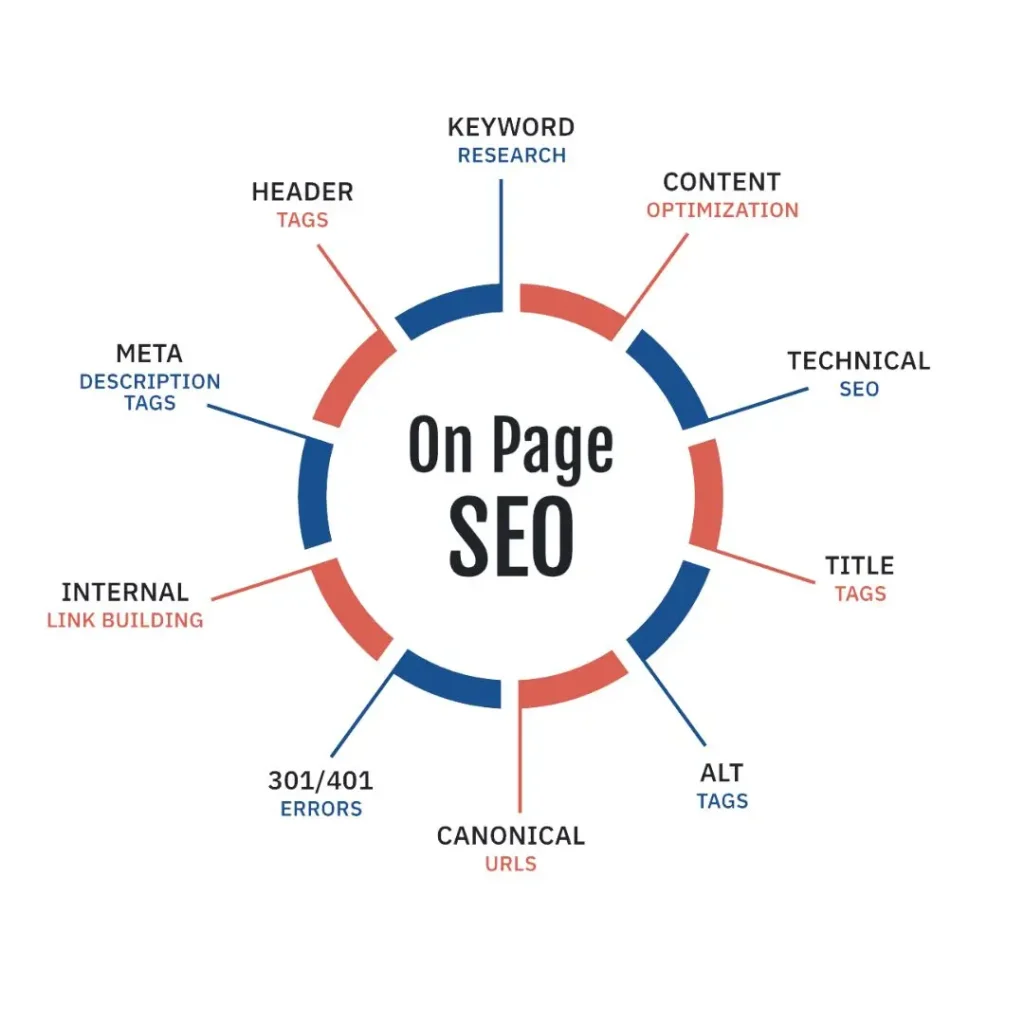Improve rankings and increase leads.
When visitors land on your website, all aspects of your website should collaborate to provide clarity, trust, and, regardless of whether a website visitor consciously recognizes it or not, value. On-page SEO is about a lot more than just using keywords; it is about creating an experience that resonates with people while providing confidence to the search engine.
Think about it like this: building a bridge, one side is the audience looking for answers, and the other side is the search engine that is around to serve the best results. Well done on-page. SEO is when your content is the bridge; it is clear, strong, and reliable.
What Makes On-Page SEO So Powerful?
- Optimized for Search & Humans Alike—Create highly relevant titles, meta descriptions, and content that respond to what your audience is looking for—and what Google is indexing.
- Build Trust and Authority–When your content is useful, well written, and polished, you become a trusted resource. Users and search engines recognize the value of your pages when they include helpful information.
- Encourage Action – Good navigation, good messaging, and good CTAs help people become leads—or even excited customers.
- Smart Internal Linking – Connect related content naturally to keep users engaged and help search engines understand your site’s structure.
5 Tools We Use for On-Page SEO

Yoast SEO

Moz Link Explorer

Screaming Frog

Ahrefs Site Audit

GTmetrix
Types of SEO service We Provide
Creating SEO-optimized website content involves several key strategies and best practices to ensure your website ranks well in search engine results and attracts the right audience. Here’s a guide to help you create effective SEO website content:
How does it work
Custom On-Page SEO Strategies


SEO is not about “stuffing” words. It’s about using the correct words that match the real needs of the user and incorporating them into your content naturally.

- Titles & Meta Descriptions—Clear, compelling, and unique for each page, and catchy enough to get the reader to click on your link!
- Internal Linking—Smooth user navigation, much better for discoverability and authority.
- Refreshing or Deepening Content—Either on old pages or when creating new pages, we want to ensure we have enough substance—answers, clear explanations, and relevance.

Well-structured layouts, engaging headings, and strong calls to action turn browsing into meaningful action.

As SEO is not one and done, we also take time to monitor what works and what does not work, refining the content, strategy, and structure to ensure we keep nailing it and moving forward!


What We Do In On Page Optimization
Technical Issue Fixing
Fast load times, clean metadata, crawling ease
Keyword optimization
Choosing high-impact terms that align with goals
Page Optimization
Titles, content, links, and internal structure
Conversion Design
Layouts and messaging that guide action
Internal link building
Create linked pages for readers and search engines to follow
When Do You Need On-Page SEO Services?
Any time your website isn’t performing its best, on-page SEO services can help you. Specifically, you should consider on-page SEO services anytime you encounter any of the following:
- Your pages aren’t ranking well even after consistent publishing.
- High bounce rates show visitors aren’t finding what they need.
- Low organic traffic despite having quality products or services.
- Outdated content and weak metadata that fail to attract clicks.
- Slow page speeds or poor user experience driving visitors away.
- Competitors outranking you for the same keywords.
We will address the On-page SEO issue checklist, improve your content, site structure and user experiences and ultimately make you easier to find, more engaging and ultimately better at converting visitors into customers.

On-Page SEO Tips
On-page SEO means optimizing the various elements on your website (text, titles and headings, images, meta tags, internal linking, etc.) to help search engines understand your pages easier and rank them appropriately. In addition, on-page SEO means creating a good user experience for your visitors.
If you do not conduct proper on-page SEO, search engines may have a hard time understanding your content, leading to poor rankings in search results. When you optimize your on-page SEO, it will help you to attract more qualified visitors, earn trust with your users, and increase conversions.
On-page SEO refers to everything that happens on your website, which can include content quality, keyword use, and technical site structure. Off-page SEO refers to the other factors that are outside of your website (backlinks, social signals, online reputation, etc.). On-page SEO and off-page SEO will both work together to deliver better rankings.
An SEO audit is done to pick the areas for improvement. It is nothing but analyzing your website’s performance, content, and structure.
Certain improvements can take effect as quickly as a couple of weeks, but in most cases websites see noticeable results within 2–3 months. The time required varies by competition, website size or structure, and how quickly search engines re-crawl your optimized pages.
Yes. Even if your content is great, it may not perform well without being properly optimized as part of an effective on-page SEO strategy. On-page SEO helps make sure your content is findable, readable, and optimized for user intent and search engines.
You should consistently change and update your on-page SEO processes. Both search engines and expectations from users are constantly evolving. Regularly checking your on-page SEO every few months and after major updates to Google will better position your site to compete and remain visible.
Yes. What is part of on-page SEO? involves technical fixes like optimizing images, minimizing code bloat, and making sites mobile-friendly—all of which improve page speed. Speed is important for rankings but also to improve user experience.
